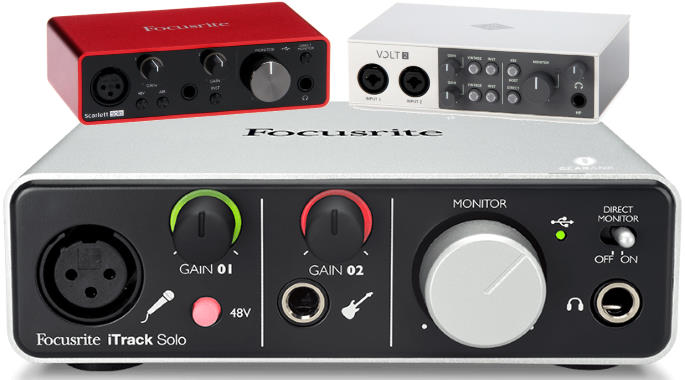
Our resident audio engineer presents his picks for the best audio interface for iPad and iPhone, proven to work properly via Lightning cable or USB adapters.
Disclosure
We recommend all products independently of 3rd parties including advertisers. We earn advertising fees from:
• • • • •

• • • • •
Amazon
As an Amazon Associate we earn from qualifying purchases.
• • • • •
If you’re looking to connect your iPad or iPhone to an audio interface, you might be confused by all the options available. You might want to record your voice, music, podcasts, or anything else, but how do you know which audio interface is best for your needs?
In this article, we’ll help you choose the right audio interface for your iPad or iPhone. We’ll explain the different types of audio interfaces, what to look for when choosing one, and the pros and cons of each model. We’ll also give you our top recommendations based on research and user feedback.
By the end of this article, you’ll know exactly which iOS audio interface to buy for your iPad or iPhone. You’ll also learn how to set it up and use it with your device, and what software and accessories you might need to enhance your recording experience.
If you are new to the world of USB audio interfaces, you may want to read our article on what is an audio interface first. Otherwise read on for our thoroughly researched recommendations.
Note that our recommendations are limited to audio interfaces that cost less than $200. You can still find more expensive USB-compatible options in our guide to USB Audio Interfaces.
The Best iPad Audio Interfaces
| Gearank* | SRC* | Check Price | ||||||
|---|---|---|---|---|---|---|---|---|
| Lightning Compatible | ||||||||
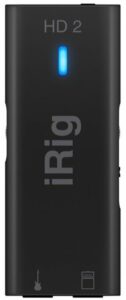
|
IK Multimedia iRig HD 2 | 88 | 4100+ | |||||
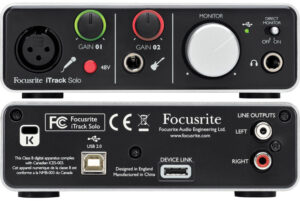
|
Focusrite iTrack Solo | 87 | 400+ | |||||
| Compatible USB Interfaces | ||||||||
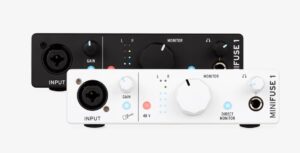
|
Arturia MiniFuse 1 | 94 | 1100+ | |||||
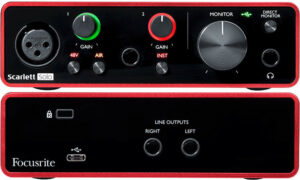
|
Focusrite Scarlett Solo 3rd Gen | 94 | 29050+ | |||||
Best iPad Audio Interfaces - Lightning Compatible
You might be wondering "Can I use audio interface with iPad?". The answer is yes, and you can find one with a lightning cable connection that is very convenient. Here are the top-rated iPad audio interfaces that allow for easy out-of-the-box use, eliminating the need to purchase separate USB to lightning adapters.
IK Multimedia iRig HD 2 Guitar Audio Interface
Cons
- One trick pony - only for guitar
Pros
- Easy to set up and use - no external power required
- More convenient for guitar than a regular interface
- Turns your iPad into a guitar headphone amp with lots of effects for practicing
When the original iRig hit the scene, it revolutionized guitar tone possibilities. It enabled guitar players to use their mobile devices as music production platforms, effects units, and even as live performance tools.
The iRig HD 2 is the successor to this legacy with an upgraded 96kHz sampling rate and a 1/4" output jack for connecting your virtual rig to a real amp or P.A. system.
This is a convenient iPad audio interface when you want to use your iPad to practice guitar. But it's not limited only to practice duties, it also lets you record audio into iPad apps.
Even though it only comes with the cut-down version of AmpliTube, you can still spend hours enjoying different effects through the headphone output. As a bonus, it also works as a plugin for your DAWs like Pro Tools, Reason, Logic, and more.
The combination of the iRig with AmpliTube means you can use your iPad as a versatile guitar headphone amp with more sounds than you typically get from regular ones.
You can even use this as a live guitar iPad interface, where the iPad is used as an effects unit.
If I had a complaint it would be that this iPad and iPhone audio interface is a one-trick pony, you can use it for guitar but nothing else so it's a piece of gear that's more of a guitar accessory than an iPad device.
The IK Multimedia iRig HD 2 is a great audio interface for guitar-specific uses. With AmpliTube bundled in, the combination gives a lot of freedom for tonal exploration for the tone-chasing guitar player.
Specifications
- A/D Resolution: 24-bit/96kHz
- Connectors: 1 x USB Micro-B (also includes lightning cable)
- Simultaneous Channels: 1 x 1
- Inputs: 1 x 1/4" (instrument)
- Outputs: 1 x 1/4" (amp processed/amp thru)
- Features: High-quality, instrument-level 1/4" Hi-Z input jack, Adjustable input gain, 24-bit A/D conversion.
- Power: Bus Powered
- Phantom Power: None
- Bundled Software: AmpliTube SE
| Website | Source | *Rating Value |
| Guitar Chalk | Bobby | 86/100 |
Focusrite iTrack Solo Lightning
Cons
- Needs a separate USB cable for power when used with the iPad
- Gain adjustments are tricky
Pros
- Great for mobile recording - particularly for speech
- Solidly built - it's safe to carry on your travels (reasonable care assumed)
- Perfect for your first 'serious' interface
The Focusrite iTrack Solo Lightning is a versatile iPad audio interface that comes in a mini-rack form factor.
As the label implies, this version comes bundled with a lightning cable. This makes it a compatible audio interface for ipad and other modern iOS devices out-of-the-box.
Note that lightning cables don't provide power so you need a separate USB power adapter. Another issue is that this will not charge the iPad while in use. You don't however need the adapter when running it off your laptop or PC.
The iTrack Solo Lightning is meant for the entry-level market. It's great for recording speech in addition to music demos, which makes it a good piece of Podcast Equipment to have.
If you're going to record songs to release commercially, then I recommend going for the Scarlett Solo instead. That is, if you don't need the Lighting connection. I prefer the preamps on that model, they also provide more gain.
One thing you'll notice is that gain adjustments can be a bit tricky at first, but that's a non-issue once you've got the settings dialed in just right.
If you're accustomed to the sound of Focusrite preamps and want something portable, the iTrack Solo is a good pick. Even if it's your first or only interface, Focusrite's preamps have a reputation in the industry as being one of the best. If good raw tracks are what you need, then this iPad or iPhone audio interface is a great pick.
Specifications
- A/D Resolution: 24-bit/96kHz
- Connectors: Lightning, USB
- Simultaneous Channels: 2
- Inputs:1 x XLR, 1 x 1/4" Instrument input
- Outputs: 1 x RCA Monitor Outs, 1 x 1/4" Headphones
- Power: USB
- Can charge IOS unit: No
- Phantom Power: Yes
- Bundled Software: Ableton Live Lite, Novation's Bass Station, Focusrite Scarlett Plug-in Suite, 1GB Loopmasters Samples.
| Website | Source | *Rating Value |
| Audiofanzine | mrjason | 80/100 |
Best iPad Compatible USB Audio Interfaces
These are top-rated USB Audio interfaces that can work with the iPad via Apple's Lightning to USB adapter, or Camera Connection Kit. These interfaces work with the iPad because they are USB audio Class Compliant which means they don't need proprietary drivers.
The standard USB adaptors won't be able to charge your iOS device and generally won't supply enough power to these interfaces so they will need a dedicated power supply.
Arturia MiniFuse 1
Cons
- MIDI Controllers that require voltage higher than 5v might not be compatible with the built-in USB hub
Pros
- Plug and play connection out of the box
- Has buttons/knobs for each function (instead of some multi-function knob or a screen)
- Great bang for buck
The Arturia Minifuse 1 is a compact and stylish audio interface that offers a plug-and-play experience out of the box. It has a sturdy metal case and a large monitor knob that is easy to adjust. Additionally, it features buttons and knobs for each function, such as direct monitoring, phantom power, and input selection, making it convenient and intuitive to use.
The Minifuse 1 has a single combi input for mic, line, or guitar and a headphone output. It can record up to 24-bit/192kHz with a dynamic range of 110dB and a gain range of 56 dB. The drivers are snappy and allow for low-latency monitoring and recording. The Minifuse 1 also has a generous software bundle that includes Ableton Live Lite, Guitar Rig 6 LE, and four premium Arturia plug-ins that add character and improve audio quality.
However, the main drawback of the Minifuse 1 is that it has only one input, limiting your recording options. You cannot record two sources at once or sing and play simultaneously. Additionally, you must be careful with the MIDI controllers you plug into the built-in USB hub, as some may require more than 5V of power and may not work correctly. The Minifuse Control Center app is also very basic and offers little control over the input, output, or loopback settings.
Overall, the Arturia Minifuse 1 is an excellent way to interface to iPad and iPhone apps. It is perfect for beginners, hobbyists, and mobile musicians who need a simple and reliable solution for recording and monitoring. It has a sleek design, a smooth connection, and decent sound quality. It also comes with a valuable software package that enhances your production. However, consider other options if you need more inputs, MIDI I/O, or more advanced features.
Specifications
- A/D Resolution: Up to 24-bit/192kHz
- Connectors: 1 x USB-C, 1 x Type A
- Simultaneous Channels: 1 x 2
- Inputs: 1 x XLR-1/4" combo (mic/line)
- Outputs: 2 x 1/4" TRS
- Power: USB bus powered
- Can charge IOS unit: no
- Phantom Power: Yes
- Bundled Software: Ableton Live Lite, Analog Lab Intro, Auto-Tune (3-month subscription), GUITAR RIG 6 LE, Splice (3-month subscription)
| Website | Source | *Rating Value |
| Sound on Sound | Robin Vincent | 94/100 |
Focusrite Scarlett Solo 3rd Gen
Cons
- Absence of MIDI In/Out ports is a slight inconvenience for those using MIDI controllers or instruments
- Can be buggy with some communication software
Pros
- A solid choice for budding audiophiles and professional musicians alike
- Aesthetically pleasing design compact that feels robust in a sturdy metal casing
- Low-latency monitoring allows monitoring recordings in real-time without any noticeable delay
- Improved preamps that deliver crisp and clean sound
Specifications
- A/D Resolution: 24-bit/192kHz
- Connectors: 1 x USB Type C
- Simultaneous Channels: 2 x 2
- Inputs: 1 x XLR, 1 x 1/4"
- Outputs: 2 x 1/4"
- Power: USB bus powered
- Can charge IOS unit: No
- Phantom Power: Yes
- Bundled Software: Focusrite Control 2, Ableton Live Lite, 3-month Avid Pro Tools Artist
The Focusrite Scarlett Solo 3rd Gen is a compact and affordable USB audio interface that offers great sound quality and features for recording vocals and instruments. It has one mic input, one instrument input, two outputs for speakers and headphones, and a switchable “Air” mode that emulates the tone of Focusrite’s ISA preamps. The interface comes with a bundle of software and plugins to get you started with music production.
I've used several Focusrite interfaces in the past and I have good experiences with the Solo’s preamp performance, especially with dynamic and condenser mics, and the build quality of the device. I also like the additional gain and lower noise floor of the 3rd gen model. However, I find some drawbacks with the Solo, such as the shared volume control for headphones and speakers, the underpowered headphone output, and the buggy compatibility with some software like Discord.
Note that there is now a Focusrite Scarett Solo 4th Gen available, which means you can get the Solo 3rd Gen at cheaper prices. It will take time to prove if it has the same very high quality build as the 3rd Gen.
Overall, I recommend the Solo for anyone who wants a simple and effective audio interface that can pair well with even the most expensive microphones. It works well as an iPhone, iPad, or iPad Pro audio interface for those who want to take their recording quality up a notch.
You can read the full review below:
| Website | Source | *Rating Value |
| Gearank | Raphael Pulgar | 92/100 |
Things to Consider When Buying an Audio Interface for the iPad
-
Some audio equipment can work with an iPad, but it can be tricky to set up and may require extra accessories. It's better to buy an iPad USB compatible audio interface, one that's designed to work specifically with the iPad you are using - be it an Apple Lightning Connector or USB C. This will help you avoid buying additional adapters and reduce clutter.
However, if you have an older iPad that uses a 30-pin connector, you will need to make sure the audio interface you choose is compatible. Current iPads and iPhones have a USB C port, which means they no longer need Apple's Lightning cables. Moving forward, the best audio interfaces will be able to connect to iPads and iPhones using USB C.
-
These are audio interfaces that utilize industry-standard USB drivers to work. They let you transfer USB audio to iPad, iPhone and other iOS devices. And they work seamlessly with multiple operating systems. While being able to switch between your iPad and your computer is a good thing, they will need you to buy an Apple USB Camera Adapter to connect to the lightning interface on your iPad.
The main accessory people use is Apple's Lightning to USB Camera Adapter or the Apple iPad Camera Connection Kit (for older 30 pin devices). The Lightning to USB 3.0 Camera Adapter offers faster connection, but it's a bit pricier. This adapter does allow you to charge you're iPad while connected to USB which isn't possible with the other two.
Note that USB interfaces generally won't be able to draw enough power via USB port / USB adapter. This means that you may need multiple USB cables to operate the interface and power it up.
See the following section on power consumption.
-
The iPad is designed to limit the amount of power supplied to external devices. While this can preserve iPad battery life it also presents challenges for said external devices. This is the reason why most audio interfaces made specifically for the iPad need dedicated power though a few are capable of charging your iPad.
This makes them ideal for long recording sessions. Those interfaces that are 'bus-powered' have to contend with the iPad's limited power. They tend to be small one channel interfaces and features like phantom power are scaled-down, if not turned off. That said, they are the most convenient and portable options you find.
When it comes to compatible USB interfaces connected through a lightning adapter, you will need another supply of power. Interfaces that are USB bus-powered will usually not get enough 'bus power' via the lightning adapter to function. This is where interfaces that can use a dedicated power supply can come in handy.
The solution for interfaces that can only be USB 'bus-powered' is to use a powered USB hub. Although this works it does add another box and cable to your setup which can reduce the portability and convenience of the setup. Check out the video below on how to connect bus-powered interfaces with the iPad:
-
The USB audio interface is an integral studio equipment for home and mobile recording. If you're planning to record vocals and other instruments, you'll want one that comes with both 1/4" and XLR inputs. Note that electric guitars, basses, and other instruments need a higher impedance than line-level inputs. Even though they use the same 1/4" connection. So look out for connections or switches labeled 'Instrument' or 'Hi-Z' to see if an interface can handle these properly.
A workaround for this is to use a DI Box which converts instrument signals into line level before going into the audio interface. Another important consideration is having a 48V phantom power switch. This is the standard when you're planning to use condenser mics. Another workaround is to connect a mixer to your audio interface, this will expand your input options for plugging in more dynamic and condenser microphones.
Some interfaces also provide ADAT connections to allow you to add up to 8 extra tracks via a separate ADAT audio interface.
-
Many of today's affordable audio interfaces come with the same mic preamps as expensive audio interfaces. This means that even in the entry-level market, you are getting good sound quality with low Equivalent Input Noise (EIN). These preamps also generally work well with instruments like guitars, bass, and keyboards. This is a big plus for those who prefer real instruments vs virtual instruments. Other specs to watch out for include Bit rate and Sample Rate, as these will impact the resulting sound quality.
You can also expand your inputs and preamp options by using a Mixing Console.
Lightning Compatible Audio Interfaces
Class Compliant USB Audio Interfaces
Power Consumption
Input Compatibility
Mic Preamp Quality
Best iPad Audio Interface Selection Methodology
The first edition was published in 2016. The current edition was published on Feb 9, 2024.
We changed our eligibility criteria and selection methods for this edition with only interfaces priced under $200 being considered. We selected the 2 highest rated interfaces compatible with Apple's Lightning cable and the 2 highest rated iPad compatible USB audio interfaces - while technically any USB class compliant interface can be used with the iPad, we made our own determination as to which non-lightning ones were eligible.
Note that Apple has switched their current devices to USB C. This means easier compatibility, and audio interfaces like the Universal Audio Volt won't need to be lightning cable compatible to work with the latest iPads and iPhones.
We collected rating and review data from store ratings, forum discussions, user videos, expert reviews and similar feedback sources to process with the Gearank Algorithm to produce the rating scores out of 100 that you see above that were the basis for our selection. During this process we collected data about 43 eligible interfaces from over 68,500 sources. For more information about our methods see How Gearank Works.
About the Author and Contributors
Here are the key people and sources involved in this guide's production - click on linked names for information about their music industry backgrounds.
Lead Author & Researcher
Raphael Pulgar
I've been an audio engineer for 20 years specializing in rock and metal recordings. I also play guitar and produce original music for my band and other content creators.
Some of the recording gear I regularly use in my studio includes the Focusrite Scarlett 18i20, Focusrite Scarlett Solo, Samson QH4 Headphone Amp and Cloudlifter CL-1. My main mics include Aston Origin, Aston Element, Shure SM57, Rode NT1, Rode PodMic and MXL V67G.
Contributors
Alden Acosta: Product research.
Jerry Borillo: Product Research and Illustration.
Jason Horton & Alexander Briones: Editing.
Media
Main/Top Image: Compiled using photographs of Focusrite Scarlett Solo 3rd Gen, Focusrite iTrack Solo and Universal Audio Volt 2.
The video has been embedded in accordance with YouTube's Terms of Service.
The individual product images were sourced from websites, promotional materials or supporting documentation provided by their respective manufacturers except for the UA Volt 2 Speaker and Headphone Controls which was photographed by the author.
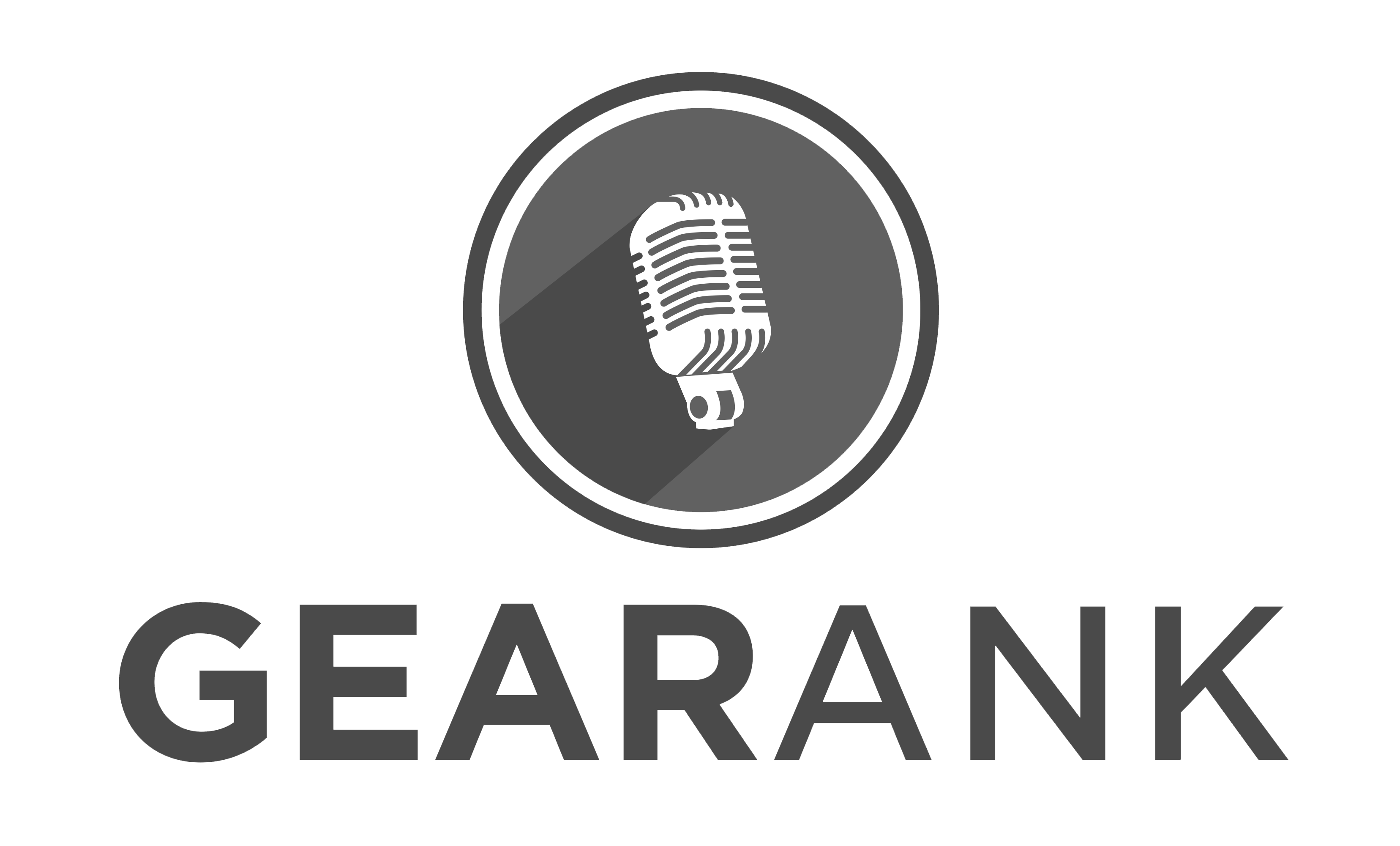
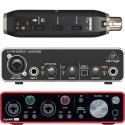
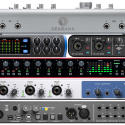
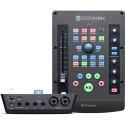
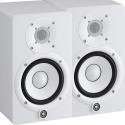
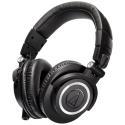
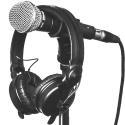
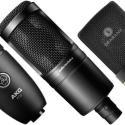
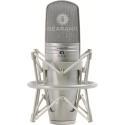
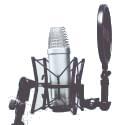
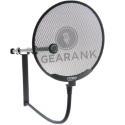
I’m using Acapella: Music Collab App from Mixcord on a 2020 iPad Pro for recording my cello pieces. I have an external USB Apogee mic and 1/4″ headphones. I can’t find an interface that meets all these pieces. The recent one I purchased did not power up my mic. Any help would really be appreciated. Thanks. Cindy
As a result of our August 2022 Edition being published, and particularly due to the impact of the new $200 price limit, the following interfaces came off the recommended list above:
We’ve removed the Rode i-XLR from the recommended list above due to a lack of availability.
Publication of our September 2021 Edition resulted in the following interfaces coming off the recommended list above:
We’ve removed the iZotope Spire Studio from our recommended list above due to it being discontinued.
Our October 2020 update resulted in the following interfaces coming off the recommended list above, but you can still see our analysis of them:
Hi all,
I’m new to the digital recording game – playing massive catch up game here.
What digital audio interface works with the iPad Pro 2018 (USB C) without the need for first installation on a regular MAC OS first? (as the Focusrite 8i6 that i bought requires)
I’m looking for something that would be able to multi track at least 2 tracks live hopefully both with powered XLR inputs as well as 1/4 inch instrument inputs and your usual monitoring outs and MIDI.
Is there any product that does all that with good quality pre amps and low latency for the iPad Pro 2018?
I am currently researching:
Yamaha AG06
Steinberg UR22 Mk2
Audient ID4
If anyone has a great piece of gear to recommend that would new fantastic.
Failing that..
Can DAWs like the Focusrite that initially need to be installed on a MAC OS, can they then operate on an ipad without the need for a permanent desktop/laptop MAC OS to be connected to?
I hope that makes sense and thank you
Chris
My Roland Duo Capture does everything you want. It’s also the only interface I know that is battery powered. 2x XLR with 48v (from 3xAA batteries!) ¼ phones jack, MIDI in/out, switchable impedance. Needs a lighting to USB adapter but is perfect with GarageBand.
Look at iConnectAudio4+:
https://www.iconnectivity…
I’ve had great luck with this for years.
And if $ isn’t too big a barrier, the Apogee Duet should be on the list. https://apogeedigital…
As a result of our October 2019 update the following interfaces came off our recommended list but you can still see our analysis of them:
Bacon Sandwich! The irig hd 2 is NOT mobile friendly. You cannot output through ipad speakers, headphones or external amp only. And, for me, it’s a major complaint. So, there you go, at least 1 major complaint for the irig HD 2…
I’d like to use my Ipad with my guitar so thinking . . . Xvive wireless from guitar to “some interface device” to Ipad through a lightning cable. Can I then use bluetooth headphones?
Please suggest a method so that I’m “wireless/bluetooth” to my Ipad
Thank you
Does the new iPad Pro’s rumoured USB-C connection make hooking up my audient ID4 an even more attractive option compared to recording separately with say the Zoom F4?
I’d say that’s partly a matter of personal preference and what kind of recording you’re doing.
For example the Zoom F4 is good for field recordings when you’re shooting videos, would you be comfortable using an iPad Pro on location?
If you mainly intend to record music, then in the long run you’ll find using a good interface like the ID4 in conjunction with software will make recording, editing and mixing both more convenient and flexible.
Nice work here, thank you.
I imagine the list is missing iConnectivity’s iConnectAudio4+ interface because of some bad reviews (~68% on amazon and sweetwater, though most are 5-star on both…) but wonder if should get an “Honorable Mention” or “YMMV” slot at the bottom of this list because of its particular feature set for iOS musicians. In addition to regular 4 channel audio and MIDI IO… It’s Lightning Compatible. You can plug two iOS devices and a computer in at the same time. It will actually charge the iOS devices while in use. You can route audio and MIDI back and forth between any of the connected devices internally. It has a USB host port which can be connected to a hub allowing for up to 8 additional USB devices to be hooked up.
The preamps ain’t Apogee or RME but they’re plenty good and certainly on or above par with the other items listed here.
Disclaimer: I am not affiliated with iConnectivity in any way other than I gave them money and love the interface. 🙂
Thank you Will for both your suggestion and for stating your reasons so clearly.
iConnectivity is a very reliable brand when it comes to MIDI and they dominate the recommendations in our guide to The Best MIDI Interfaces.
Also, the iConnectAudio4+ (rating info) has some serious supporters in addition to you including; Music Radar – Jono Buchanan and Ask Audio – Matt Vanacoro.
However, a vast number of individual users have given it a rating equivalent of well less than 4 stars in their reviews and comments and that has dragged down the overall rating for the iConnectAudio4+. Alexander, the lead researcher and author of this guide, informed me that his investigation showed there were a large number of plug-and-play / compatibility issues, meaning that if it worked it was great, but for those that had problems getting it working, well – they gave low ratings in response.
Thank you again for the suggestion, however until solutions to the compatibility issues are reflected in user experiences, we won’t be comfortable giving it a featured position in this guide.
Wow, what compatibiity issues?
I’ve used the iConnectAudio4+ for years and have had no problems at all. I clean install macOS every year and update iOS as well. Never a problem.
Great flexibility, can record to Mac and/or iOS (as a back up) simultaneously (but never needed it). And as stated, it powers the iPad while it is recording. Great device. I wish they made one the didn’t need to be plugged in.
It seems like people thought it was plug and play, but the instructions require a proper setup first. There is an app in the App Store that can be used for the fairly simple setup and then it’s good to go!
I use the apple composite A/V cable and a 30 pin/lightning convertor to run audio into my mixer. The A/V cable has L and R stereo RCA out that sends the line level audio to my mixer. It also has a USB in the same bundle. Connecting that to power via an AC transformer allows line level sound and charging simultaneously. Note that the ipad volume controls will not function in this setup. I adapt the cables to 1/4″ for insertion into the mixer.
In response to the power consumption part more specifically that video about how to using powered bus hubs. Couldn’t you in theory just plug the interface and wall outlet into the camera adapter. And then obviously the camera adapter into the iOS device. By passing or simply not using the usb powered hub?
Anyone tried connecting behringer umc204hd to iPad with lightning camera adaptor and made it work to send audio from interface to iPad in garage band?
I ended up buying a Roland Duo Capture EX, that works fine with ipad/iphone as well with PC.
I am thinking about to buy a Behringer UMC 204HD but I would like to know if it can be connected to iPhone 6S instead of iPad. For example i would like to record a video from my iPhone Camera but audio from my condenser microphone MXL/990 plugged into UMC 204 HD and connected to iPhone via CCK cable. Because if it does not work I will buy a iRig pro Duo.
Tks
I am actually irritated at the lack of research and incompleteness of this article. None of Presonus’s iOS interfaces are represented here. In my opinion, they are hands down the best mobile interface. They are high quality I/O converters, lightning compatable, and will trickle charge. I do not represent, work for, or am endorsed by Presonus. I am a musician hobbyist, with a passion for great gear.
Hi Dan,
I can understand you making the mistake of thinking we haven’t researched PreSonus audio interfaces in detail, because you probably didn’t realize you could have looked that information up in our Music Gear Database.
Here are several PreSonus interfaces that have been placed onto short-lists for detailed analysis when we have researched various audio interface categories – as you can see the PreSonus AudioBox iTwo simply doesn’t have high enough ratings for us to recommend it at this time.
Jason.
No mistake, Jason. Please allow me to explain. Based on the Gearank article you sited, the iTwo is ranked 83 with over 3x the amount of sources as the top listed lightning compatable interface. The iOne is an even closer competitor, at a lower price point with more features. Furthermore, I don’t know where your “lack of ratings” is coming from. Gearank’s OWN RATING SYSTEM invalidate your statement. Since the inception of gearank’s article in early 2016, the Presonus ratings for their iOS devices have greatly increased on respectable user ranked based platforms, specifically the iOne which has more reviews than the top competitor. My position is firm. I continue to find fult in this incomplete article. I am simply stating the facts. This article calls for an update. I find the “update” earlier this year to be partial.
Hi Dan, you are clearly very passionate about interfaces from PreSonus and that’s a good thing because if everyone had the same opinion on everything then life would be boring and music would be dull.
What I meant about the ratings was that the iTwo has lower ratings than the ones we recommended – that was the same for the iOne which didn’t make it onto our short-list because a quick analysis showed the ratings would come out too low for us to recommend it before we did the extra work of publishing a rating for it.
Keep in mind that the ratings we publish are a statistical measure of the overall market satisfaction with a product and as a result some of the sources we have used will have higher ratings while others will have lower ratings for a single item. If you have written reviews, posted forum comments or rated those interfaces (on sites other than Gearank.com) then it’s quite likely that your opinion has contributed to the ratings we publish.
Please feel free to post a follow-up and tell us what those respected sources are that you mentioned, and if by some chance they aren’t already in our sample set, I’ll ensure they are considered next time we update our recommendations.
Haha Dan slinks away, perhaps reflecting on his unnecessarily outraged postings.
I am wanting to do a Podcast using
Garageband and want an option for a 3rd mic. Would the Behringer UMC404hd connect the same way? Also in Garageband would it be recorded as one track or separate for each mics I have? Thanks!!
The Behringer UMC404HD connects the same way as the Behringer UMC204HD above which means you also need a Lightning to USB Adapter (link to Sweetwater).
It will also let you record with up to 4 mics at the same time with each mic being recorded to a separate track.
Follow up question regarding above mentioned products. Is there a way to connect a cell phone to the 404HD to do interviews?
I haven’t done this myself, but cell phones typically have a jack for plugging in headsets, usually earbuds with a mic, and you could plug that into any audio interface including the UMC404HD.
You will need an adapter to convert the output from your phone, typically a 1/8″ TRRS (Tip Ring Ring Sleeve) socket, to a 1/4″ TRS (Tip Ring Sleeve) to plug into your audio interface. Different phones can have different TRRS configurations so you’ll need an adapter that’s specific to your phone.
Thanks again, Jason!
Hopefully last question. I bought the UMC404HD, connected to iPad and use Garageband. Recording works well but I cannot hear what I have recorded on playback through the headphones connected to interface. Thoughts on how to correct?
Hello Lenny,
Have you ensured that the Phones knob is set correctly on the interface? Also if you want to use the interface as your playback, you’ll have to set the audio output accordingly within the app. Hope this helps!
Thank you very much for your assistance, Jason!
Today we’ve removed the Focusrite iTrack Dock from our recommendations above due to a lack of availability.
Have just bought the UMC204HD and plugged it into my iPad Pro 10.5” using the Apple lightning to USB 3 adapter which has both USB and lightning sockets so you can supply power at same time. It powered up the UMC204HD and the iPad recognised it immediately, no warnings. Opened Auria Pro, all working perfectly (still had to set the iPad volume first, as reported). The iPad was charging as well. Don’t know if there’s anything different with the iPad 10.5 like if it has more power ability but this is perfect for me. Don’t need a powered usb hub, no mess of excess cables. Happy bunny, me!
Two questions:
1) I understand that FocusRite doesn’t recommend the ‘bigger’ iPad Pro users connect to this via the adapter, but what defines ‘bigger’?
2) If 9.7″ is too big, I can’t use this, which begs the question: What else out there is compatible AND pro-level quality for a 9.7″ iPad Pro?
Have you seen the DPA d:vice? That thing is 96k 24 bit and bus powered 2 condensers. And it’s DPA, their mics are the best in the world!
I’d like to find out is if these audio devices allow song cueing for DJs. Many iPad DJ apps allow you to cue up / listen to song on the headphones separately from the main – but unfortunately it seems like lot of the good iOS compatible audio hardware doesn’t support this feature.
(Mainly just need an audio interface without silly turntables on them)
Have you checked Numark’s DJIO2?
Get the Zoom U-24. Works great as a USB/battery-powered 2-channel audio interface, and works great as a stand-along mixer, mic preamp and DJ cueing interface. It can’t understand why it’s not on this list. Best product I’ve ever bought.
The Zoom U-24 didn’t have sufficient ratings to make it onto our short-list when we did the research for this guide.
I’ve had a quick look at the latest ratings and written reviews are mostly positive so it might make a good DJ interface.
Audio interfaces with three or more output channels should be compatible with cue mixing. Three because you need two channels for stereo output, and one (or two for stereo) for the headphones. This should work if the DJ app lets you send the cue and main audio to separate output channels.
The Behringer U-Phoria UMC204HD has four output channels and is very affordable. You can also look at our multi-channel audio interface guide for more options.
Hi.
Any interface for iPad which offers 8 analog outputs?
Thanks,
Flavio.
Meanwhile there is a ‘bus powered’ apple usb camera adapter you can use in connection with audio interfaces. I do this. Works well.
I’m noticing there arn’t any two-channel bus powered interfaces on this list. Are there any out there? I’m at the end of my wits looking for one.
Presonus iTwo is the way to go.
It might be the case that IOS does’t provide enough power for a good two-channel microphone interface via the connection. A few years ago they reduced the power available to USB devices via the adaptor and they don’t publicly specify how much power is available for lightning / 30 pin connector.
The only IOS bus powered interface on this list is the Shure MVi which is mono. The best option to get stereo may be to go for something that can be battery powered like the Roland Duo-Capture EX.
Focusrite do one and irig I think.
Yes, I tend to agree. The iPad just doesn’t have enough “juice” for bus-powering a stereo interface. Personally, I’d be too worried to rely solely on bus power during a recording. I always feel better knowing that I’m plugged into the “wall.” If I needed to record something in the field where there were no electrical outlets I would probably use something like a portable “Zoom” recorder or something like that.